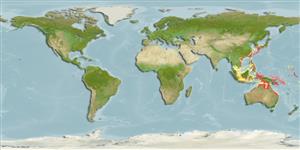>
Mugiliformes (Mullets) >
Mugilidae (Mullets)
Eponymy: This is a toponym referring to the George’s River, Australia, in the estuary of which the type specimen was taken (1895). (Ref. 128868), visit book page.
More on author: Ogilby.
Environment: milieu / climate zone / profondeur / distribution range
Écologie
marin; eau douce; saumâtre démersal; catadrome (Ref. 46888). Tropical
Western Pacific: endemic to Australia.
Taille / Poids / Âge
Maturité: Lm ? range ? - ? cm
Max length : 30.0 cm TL mâle / non sexé; (Ref. 9812)
Épines dorsales (Total) : 4; Épines anales: 3; Rayons mous anaux: 9. Greenish brown dorsally; flanks silvery; abdomen off white (Ref. 9812). Gold spots on dorsal and ventral parts of iris (Ref. 9812). Second dorsal, anal, and caudal fins with dusky margins and second dorsal speckled brown (Ref. 9812). Pectoral fin with purplish spot dorsally at origin (Ref. 9812).
Body shape (shape guide): fusiform / normal.
Form schools in coastal waters, estuaries, and bays; young may enter freshwater. Oviparous, eggs are pelagic and non-adhesive (Ref. 205). Taken as bycatch; used as baitfish for crabs and snappers.
Life cycle and mating behavior
Maturité | Reproduction | Frai | Œufs | Fécondité | Larves
Harrison, I.J. and H. Senou, 1997. Order Mugiliformes. Mugilidae. Mullets. p. 2069-2108. In K.E. Carpenter and V.H. Niem (eds.) FAO species identification guide for fishery purposes. The living marine resources of the Western Central Pacific. Volume 4. Bony fishes part 2 (Mugilidae to Carangidae). FAO, Rome. (Ref. 9812)
Statut dans la liste rouge de l'IUCN (Ref. 130435: Version 2025-1)
Menace pour l'homme
Harmless
Utilisations par l'homme
Appât: occasionally
Outils
Articles particuliers
Télécharger en XML
Sources Internet
Estimates based on models
Preferred temperature (Réf.
123201): 24.3 - 28.3, mean 27.4 °C (based on 264 cells).
Phylogenetic diversity index (Réf.
82804): PD
50 = 0.7500 [Uniqueness, from 0.5 = low to 2.0 = high].
Bayesian length-weight: a=0.01175 (0.00555 - 0.02485), b=2.96 (2.79 - 3.13), in cm total length, based on LWR estimates for this (Sub)family-body shape (Ref.
93245).
Niveau trophique (Réf.
69278): 2.5 ±0.2 se; based on size and trophs of closest relatives
Résilience (Réf.
120179): Milieu, temps minimum de doublement de population : 1,4 à 4,4 années (Preliminary K or Fecundity.).
Fishing Vulnerability (Ref.
59153): Low vulnerability (20 of 100).
🛈
